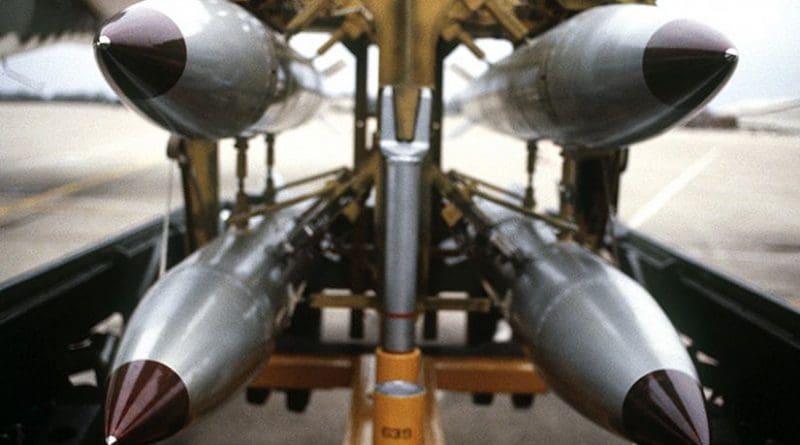Little Progress In Nuclear Disarmament Since Helsinki Summit – OpEd
By IDN
By Jonathan Power*
Everything gets said, nothing gets done. When President Donald Trump met President Vladimir Putin in Helsinki on July 16, we were promised all sorts of goodies – progress in reconciliation in Ukraine and Syria, and not least nuclear disarmament. If there is progress behind the scenes it’s not noticeable to the naked eye.
People talk about Trump being in Putin’s pocket yet when, soon after Trump became president, Putin suggested major cuts in nuclear weapons Trump turned him down. This would have been a fantastic way to start his presidency. He could have upped Barack Obama’s achievement of getting the arsenal down to 1550 warheads each. In nearly everything else he wants to destroy Obama’s legacy or minimize it. This would have been a way to do it.
This doesn’t sound to me like Putin, the supposed puppet master, was pulling the strings on his marionette, Trump.
Let that be, maybe we’ll find out the truth soon enough. Meanwhile the massive stockpile remains, despite enormous cuts (80 percent) since Cold War days. The U.S. is committed to a 1.7 trillion dollars’ improvement over 30 years in its nuclear arsenal, the price Obama had to pay to get the new treaty with Russia approved in the Senate. (It’s called New START.)
In Helsinki, Putin suggested that they extend the life of New START, due to expire in 2021, since it only requires both presidents to agree. Parliamentary approval is not necessary. But again Trump seems to be procrastinating.
Meanwhile, many rockets still remain on hair-trigger alert. Many military men worry that under pressure Trump might authorise their use and that a military used to obeying orders would initiate a launch. “A demented commander-in-chief could start a conflagration that no one could forestall, veto or stop,” says the Arms Control Association.
Added to that are false warnings caused by birds, computer malfunctions etc. There’s also the danger of rogue submarine commanders who can fire their nuclear missiles without a confirming radio signal since they have to surface to receive one. In wartime they might not be able to safely surface.
Once a Russian attack is launched (or a U.S. one on Russia), the presidents have only six minutes to make a decision if retaliation is to be implemented. Zibigniew Brzezinski, the former National Security Advisor, has talked about how he was awakened in the night and informed by the military that an attack might be on its way. He waited three minutes before he had to phone President Jimmy Carter who was also asleep. Fortunately, at that moment a second call came in, saying it had been a false alarm.
Recently in an amazing statement a group of former intelligence chiefs more or less said, according to an op-ed article in the New York Times, that the military should think twice before following Trump’s orders in a crisis.
The arms race continues. Both sides are developing hypersonic missiles, new missile defence capabilities, offensive cyber weapons and anti-satellite and counter-space weapons. Any of these could disturb the rough equilibrium of the Cold War days when it was clearly obvious that one side couldn’t have an advantage over the other.
Putin is still swallowing the bitter pill of President George W Bush’s decision to pull out of the 1972 Anti-Ballistic Missile Treaty, allowing it to press ahead with a land-based missile system that Russia views as a direct, deliberate threat.
Shuffled into a back corner is the joint statement of presidents Ronald Reagan and Mikhail Gorbachev that “a nuclear war cannot be won and must never be fought.”
Judge a person by what he does, not by what he says. The Trump Administration in its new nuclear posture review suggests the deployment of smaller nuclear bombs that will make them more useable, for example by blocking an advance of troops. It is also leaning towards widening the conditions under which nuclear weapons may be used first in response to a non-nuclear act of aggression.
This will revoke Obama-era assurances given to non-nuclear countries that the U.S. would never attack them with nuclear weapons. This would sabotage the Nuclear Non-proliferation Treaty that has done much to keep limited the number of countries that want to develop nuclear weapons.
For the last seven decades, since the end of World War 2, the world is probably living in its most benign years of peace. Yes, there are a number of civil wars but interstate wars have fallen precipitously. As a result territorial conquest has nearly disappeared.
Before 1928 the average state could expect to be conquered about once every lifetime. Now the average country will be subject to conquest roughly once or twice in a millennium. So writes Oona Hathaway and Scott Shapiro in their book, The Internationalists.
Strategists say nuclear weapons help keep this peace. Maybe they do – until something goes wrong. We can’t afford to live with a gamble like that, especially so when Trump has his finger on the button.
*Note: For 17 years Jonathan Power was a foreign affairs columnist and commentator for the International Herald Tribune – and a member of the Independent Commission on Disarmament, chaired by the prime minister of Sweden, Olof Palme. He forwarded this and his previous Viewpoints for publication in IDN-INPS. Copyright: Jonathan Power. Website www.jonathanpowerjournalist.com

